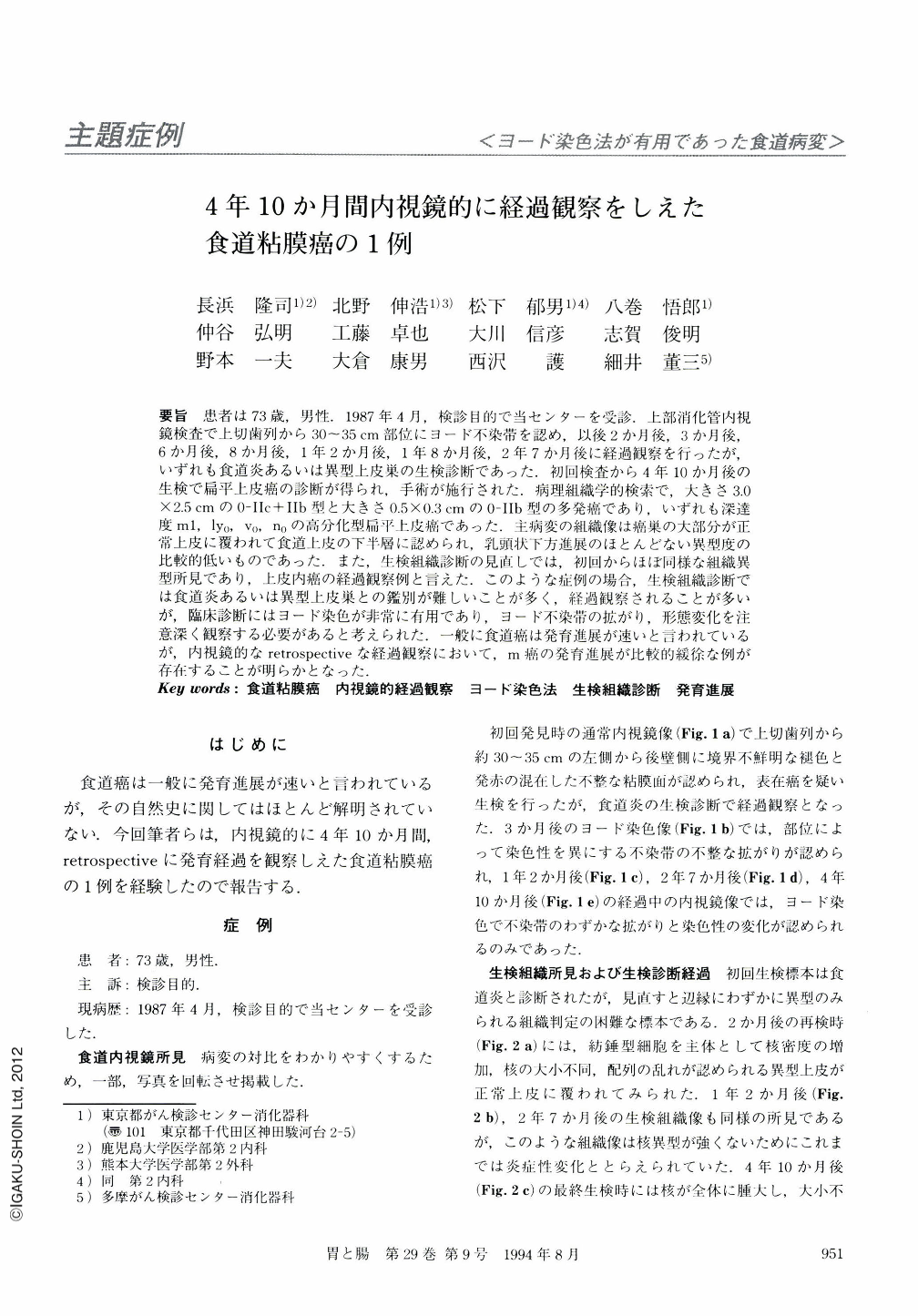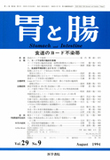Japanese
English
- 有料閲覧
- Abstract 文献概要
- 1ページ目 Look Inside
- サイト内被引用 Cited by
要旨 患者は73歳,男性.1987年4月,検診目的で当センターを受診.上部消化管内視鏡検査で上切歯列から30~35cm部位にヨード不染帯を認め,以後2か月後,3か月後,6か月後,8か月後,1年2か月後,1年8か月後,2年7か月後に経過観察を行ったが,いずれも食道炎あるいは異型上皮巣の生検診断であった.初回検査から4年10か月後の生検で扁平上皮癌の診断が得られ,手術が施行された.病理組織学的検索で,大きさ3.0×2.5cmの0-Ⅱc+Ⅱb型と大きさ0.5×0.3cmの0-Ⅱb型の多発癌であり,いずれも深達度m1,ly0,v0,n0の高分化型扁平上皮癌であった.主病変の組織像は癌巣の大部分が正常上皮に覆われて食道上皮の下半層に認められ,乳頭状下方進展のほとんどない異型度の比較的低いものであった.また,生検組織診断の見直しでは,初回からほぼ同様な組織異型所見であり,上皮内癌の経過観察例と言えた.このような症例の場合,生検組織診断では食道炎あるいは異型上皮巣との鑑別が難しいことが多く,経過観察されることが多いが,臨床診断にはヨード染色が非常に有用であり,ヨード不染帯の拡がり,形態変化を注意深く観察する必要があると考えられた.一般に食道癌は発育進展が速いと言われているが,内視鏡的なretrospectiveな経過観察において,m癌の発育進展が比較的緩徐な例が存在することが明らかとなった.
A 73-year-old male visited our center for upper gastrointestinal examination in 1987. Endoscopical examination of the esophagus showed an ill-defined coarse mucosal lesion mixed with discolored and reddish mucosa, located at the left and posterior side of the middle intra-thoracic portion, about 30 cm from the oral cavity. Lugol staining method of the esophagus showed an irregular shaped non-stained lesion, measuring about 3.0 cm in diameter. Histological diagnosis of the biopsy specimen was esophagitis with small atypical epithelium, but re-biopsy was carried out two months later and diagnosed as atypical squamous epithelium with severe atypia.
Followed up for four years and ten months by eight endoscopical examinations, the lugol non-stained lesion became slightly more whitish and enlarged. The diagnosis of biopsy specimens was atypical epithelium or esophagitis, but the lesion was finally diagnosed as well differentiated squamous cell carcinoma. Because of this a stripping operation was performed.
The resected specimen showed double cancers, the larger one was 0-Ⅱc+Ⅱb type cancer measuring 3.0×2.5 cm, and the other was 0-Ⅱb type microcancer measuring 0.5×0.3cm. Histopathologically, it proved to be a well differentiated squamous cell carcinoma, mostly limited to the lower half of the epithelium (m1), without papillary downward growth.
Re-examination of biopsy specimens, diagnosed as atypical epithelium, revealed almost the same histological features as the surgical specimen, so our case can be considered to be a long followed-up intramucosal cancer of the esophagus. It used to seem that esophageal cancers develop rapidly, but our case revealed that a slow-growing mucosal cancer also exists. The lugol staining method was useful in the esophageal examination, not only for the diagnosis of this type of mucosal cancer, but also in the follow-up process.

Copyright © 1994, Igaku-Shoin Ltd. All rights reserved.


